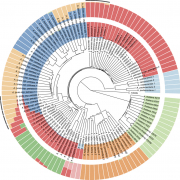Complex history of Arabidopsis speciation
Sequencing of the genus Arabidopsis identifies a complex history of nonbifurcating speciation and abundant trans-specific polymorphism
The notion of species as reproductively isolated units related through a bifurcating tree implies that gene trees should generally agree with the species tree and that sister taxa should not share polymorphisms unless they diverged recently and should be equally closely related to outgroups. It is now possible to evaluate this model systematically. We sequenced multiple individuals from 27 described taxa representing the entire Arabidopsis genus. Cluster analysis identified seven groups, corresponding to described species that capture the structure of the genus. However, at the level of gene trees, only the separation of Arabidopsis thaliana from the remaining species was universally supported, and, overall, the amount of shared polymorphism demonstrated that reproductive isolation was considerably more recent than the estimated divergence times. We uncovered multiple cases of past gene flow that contradict a bifurcating species tree. Finally, we showed that the pattern of divergence differs between gene ontologies, suggesting a role for selection.



